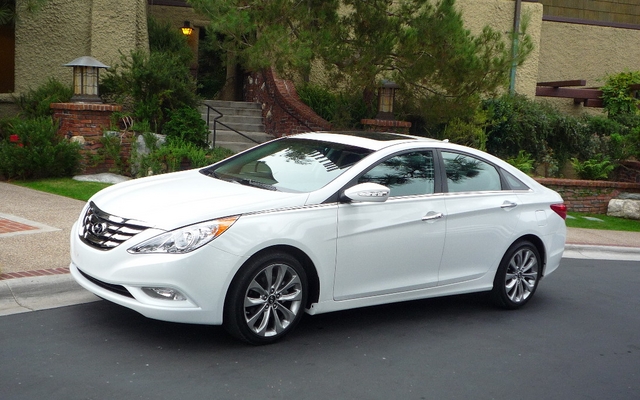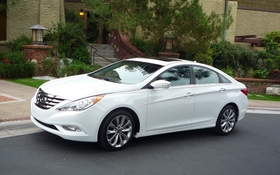2011 Hyundai Sonata Hybrid: Elegance and Technological Innovation
Until now, hybrid drivetrain technology has boiled down to two main types. The first involves placing a small electric engine between the thermal engine and the transmission. This electric engine gives a boost to the thermal engine whenever it is overtaxed, but it can operate on its own, too. Honda developed this technology on the first Insight and continues to use it on all its hybrids. The other technology, developed by Toyota for the Prius, involves thermal and electric engines which can either work individually or together. This technology is also found in the Ford Fusion and Nissan Altima.
For a few years already at various international auto shows, Hyundai has been featuring different concept cars with hybrid propulsion systems – and batteries that use a new kind of technology.
This excitement has finally come to fruition with the new Sonata Hybrid, which Hyundai recently let us try and which will reach the North America market soon. This test drive allowed us to see for ourselves that this technology is both original and exclusive to the Hyundai-Kia Group.
Ingenious technology
No one can accuse the Korean engineers behind this vehicle’s hybrid technology of plagiarism. Not only is the engine unique in more ways than one, but they also developed a battery with patented technology. Most hybrid vehicles use nickel-metal-hydride batteries. These have been around for several years, but they’re heavy and less efficient than lithium-ion batteries, largely considered the way of the future. Hyundai claims that the cylindrical shape of lithium-ion batteries limits their potential range of sizes – plus they’re complicated to make due to the large number of small pieces that go into them. Lithium-polymer technology adopts a totally different approach. Made with polymer gel, these batteries are about 20% smaller than their lithium-ion counterparts and they can be made into different shapes for use in automobiles. Moreover, these batteries do not require any type of maintenance during the vehicle’s useful life (about 10 years or 240,000 km) in all climates.
Dubbed the Hybrid Blue Drive, this system combines a 2.4-litre Theta II engine producing 169 horsepower and 156 lbs-ft of torque with a six-speed automatic transmission. Sandwiched between the two is a 30-kW electric engine offering 151 lbs-ft of torque at 1,400 rpm. These two engines produce 209 horsepower and 195 lbs-ft of torque. What’s unique from Hyundai is that even though the electric engine sits between the engine and the transmission, it can also work entirely on its own. Alternatively, the gas engine can also work independently, or the two can work together. This is something that Honda’s IMA technology cannot do. Hyundai’s secret: the clutch allows you to engage or disengage the electric engine, as needed. This mechanical system can bring the vehicle from 0 to 100 km/hr in 9.2 seconds, according to the manufacturer.
Vive la différence!
Naturally, the Sonata Hybrid had to be different than its "thermal" counterpart, both inside and out. After all, surveys indicate that potential buyers want their "green side" to be evident when they drive. To achieve this, the headlamps, tail lights, fender, lower body panels, front grille, tires and air intakes are all different than on other versions. What’s more, the Sonata Hybrid is available in an exclusive colour (exterior and interior). And finally, the marketing team would have been remiss if they hadn’t given the seats a special pattern. The dashboard is fairly similar to the "regular" version, except that a high-res screen that shows how efficient your driving is (using eight colours, ranging from grey to bright blue) is sandwiched between the speedometer and a general indicator unit. The display system compiles points in Total Eco mode over time, while an Eco Guide provides instant fuel economy feedback. The Hyundai Sonata Hybrid has the same ultra-elegant silhouette and stylish interior with superb fit and trim.
A non-descript drive
Despite all the sophistication under the hood, the way this green Sonata drives is unremarkable, or just about. But that’s not a criticism. In fact, even though you can drive in all-electric mode up to 100 km/hr, you can switch from electric to thermal or a combination of the two with complete transparency. But you have to be light-footed to stay in electric mode, lest you awaken the horses in the thermal engine. Like on any good hybrid, the engine stops when the car comes to a standstill. According to Hyundai press releases, its fuel economy is 5.4 L/100 km on the highway and 5.6 L/100 km in the city. We drove it through a mountainous area and in the city, and recorded an average of 6.1 L/100 km. This rate is not bad, considering that our driving style was not the greenest.
Aside from that, the vehicle proved neutral on corners and stable on straights. The steering is precise enough to please most drivers. Finally, the relatively light battery is a lot less obvious that the heavier ones in the Toyota Camry and Ford Fusion. The six-speed automatic transmission has a clear advantage over the competition’s CVT. And good news: the brake pedal is progressive. It doesn’t have that cushiony initial feeling that you find on a lot of other hybrids.
The new Sonata Hybrid will roll into dealerships during the first quarter of 2011. Its suggested retail price should be just over $30,000, which gives Hyundai another leg up over the competition.












